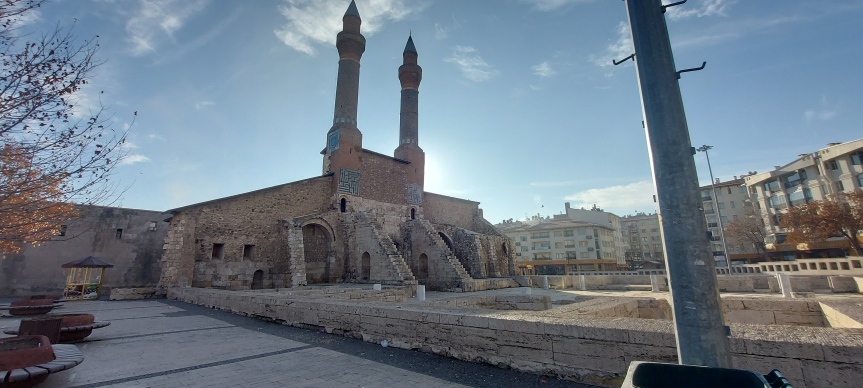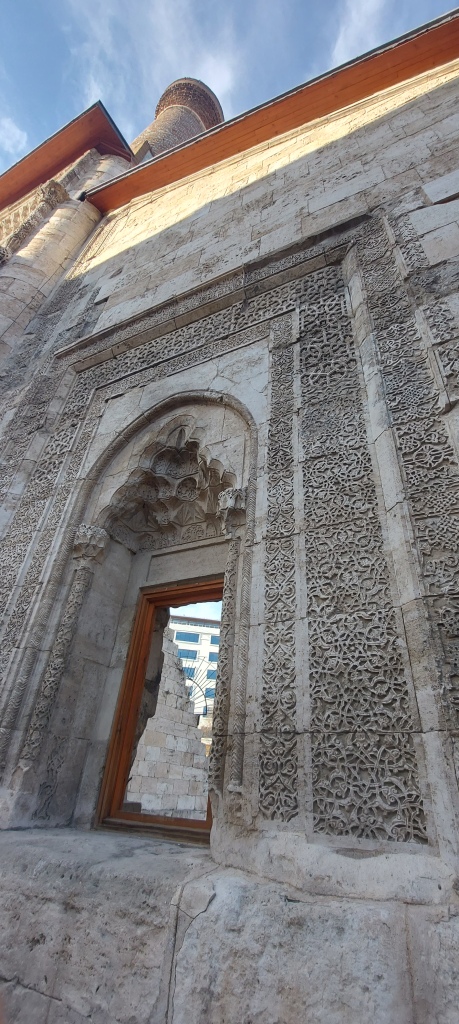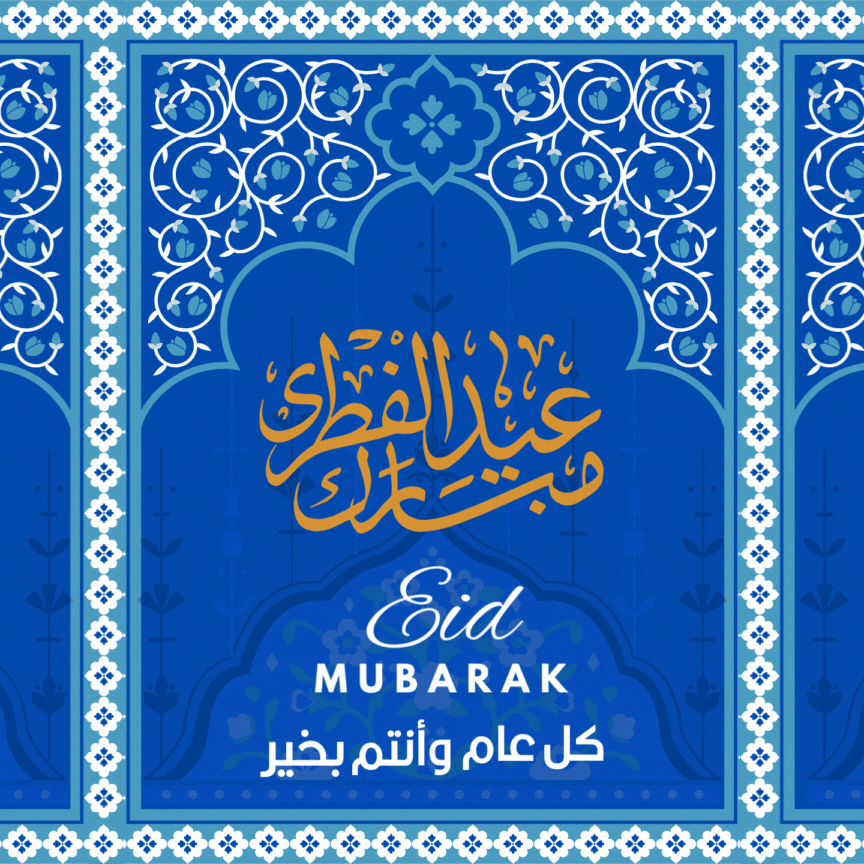
Nuzul Al Quran 1445H
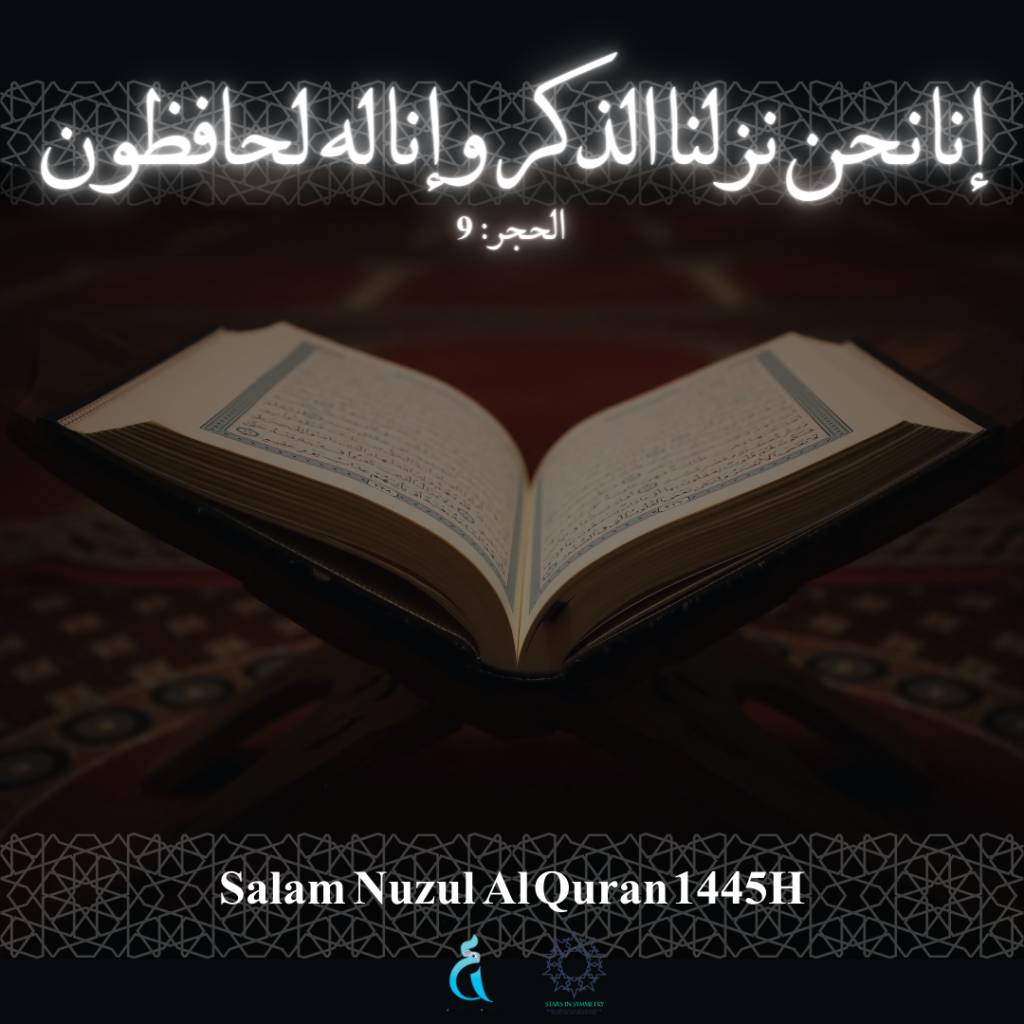
Assalamualaikum everyone and good day,
Today is the day of remembrance of the revelation of the Holy Al Quran. It is believed that on the night of 17th of Ramadan in 610CE, The Prophet Muhammad (SAW) received the first verses of the Al Quran from Allah via the angel Jibreel (AS) and since then the light of Islam came into the world, dispelling the darkness that has been covering the realms and bringing the people to the compassion of the Lord Almighty.
And with that light of Islam, comes the beauty of Islamic art and architecture as it spreads all over the world. As the Prophet himself have said that “Allah is beautiful and he loves beauty”, this idea of beauty is connected to spirituality in Islam and thus by knowing the Quran we came to know the spirituality side of the the beauty that we came to appreciate as Islamic art and architecture.
Again I wish you a happy Nuzul Al Quran, and hoping on this day we can contemplate the Quran and understand that the beauty of Islamic art is the reflection of the beauty of the message of the Quran and Islam.
Ramadan Mubarak
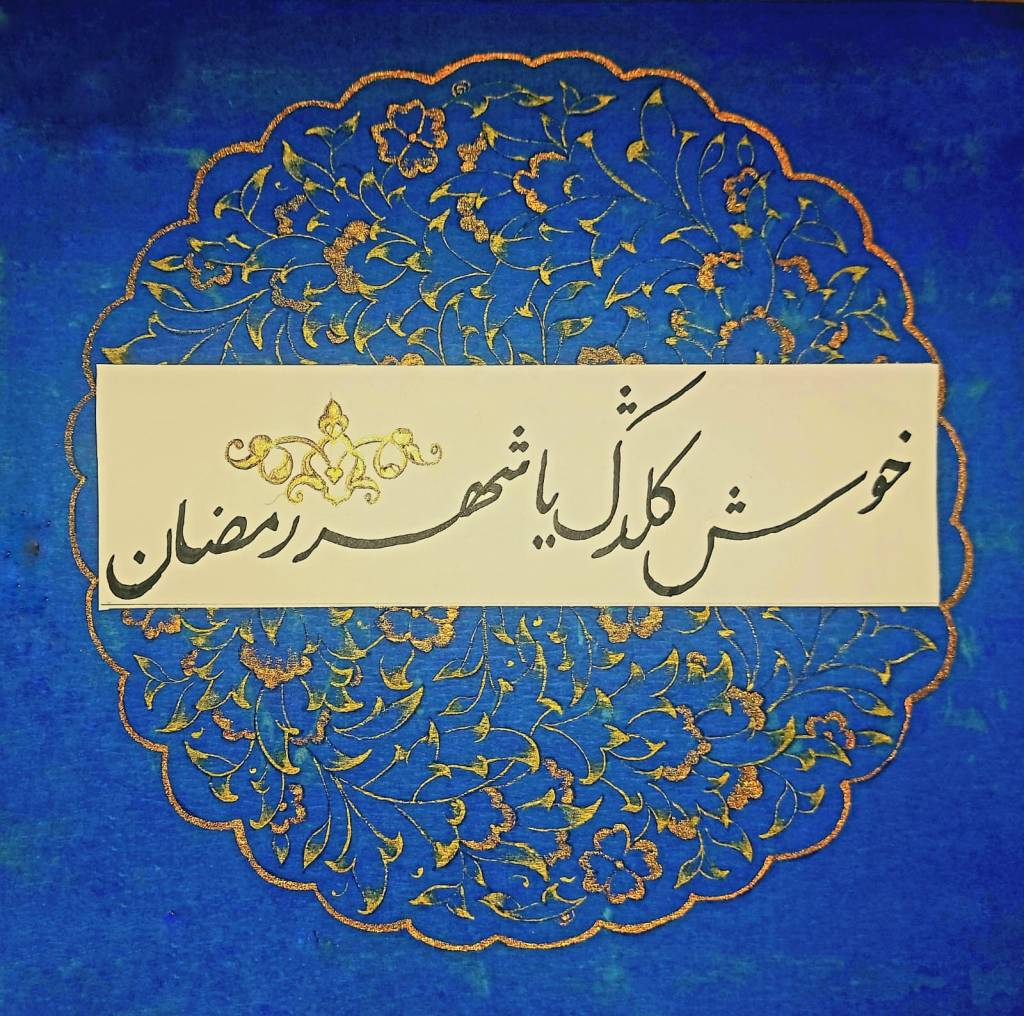
Assalamalaikum and good day everyone,
I would like to wish all of my readers a happy Ramadan, wishing for all of us to have a peaceful and fruitful Ramadan Insya Allah.
The image above is my own writing of Ottoman Turkish -خوش گلدن يا شهر رمضان Hoş Geldin Ya Şehri Ramazan, basically means welcome o month of Ramadan. And the Tezhip in the backgound is also my own work 🙂 Although everything still looks unpolished but I am still learning and hopefully one day I will get better and better.
Once again, I wish you a happy Ramadan.
Appreciation – Study Visit In Türkiye Pt.1
As I have noted before, last year I had a chance to do a self-funded study trip to Türkiye to study Islamic arts namely Tezhip (gilded illumination) and Calligraphy in an institution there as well as to study Ottoman Turkish and Turkish Language. I was there for a bit more than 2 months so I went to a lot of places and cities during my time. Unfortunately, the 2023 earthquake hit the southern part of the country and therefore many of my classes were cancelled or cut short ; many of my teachers were affected directly or worked as volunteers in the affected areas. During my times of not having my classes I would go around Istanbul to visit (in most cases, again) the historic places in that ancient city.
I arrived in Türkiye on 20th of December 2022, about 10 days before starting my course in Istanbul. After registering and handling all the necessary things for my study I took a flight and went to Sivas, a city in the eastern part of the country. This is my first time coming to this part of the country, so everything is quite new for me. I only stayed there for about 2 nights, and during my time there I had the chance to visit some of the main sights of the city.
Sivas is a beautiful and calm ancient city which is known more for its role for the establishment of the Turkish Republic, where it held the congress of Sivas and hosted Mustafa Kemal Ataturk. However, I was not there for that part of Turkish history. There was a lot of Seljuk and Ottoman heritages you can find here, although mostly you will see Seljuk period monuments. I even stayed at a Seljuk-era restored Han (inn) not too far from the city center. Also the city is very pedestrian friendly so much so in fact you can easily just walk to the city center (Kent Meydanı) and see all the points of interest there in a short time.
Just about 20 minutes walk from my hotel (The restored Han, Behram Paşa Otel) is the city centre where you can visit sights such as the the Buruciye Medrese, the Çifte Minare Medresesi and the Kale Camii. So you can actually see all the main sights here in one day unless you want to go to the Archeological Museum which is a bit north to the center, although still in a very comfortable walking distance. Most of my time I could not walk a long distance to my bad legs (which turns out to be calcium deficiency!) so I mostly walked around the city center and visited all the sights there.
First, lets talk about the hotel I stayed in – Behram Paşa Otel. It was a beautifully restored Han (caravanserai inn) built in 1576. It still has the characteristics of the original building including the lion motifs around its windows. but restored and remade into a modern hotel and restaurant. In the middle of the hotel which used to be the courtyard of the Han there is the hotel’s restaurant, which is open for breakfast for the guests and lunch and dinner for public . Some Turkish people are heavy smokers and since it is actually acceptable to smoke indoors here, all the smoke goes up to the rooms on the second floor which is as you can imagine is quite uncomfortable. Thankfully when the restaurant closes the smell ceases. The room itself was good enough for a solo traveler like me. It was small and cramped just like my own room back home. As you can imagine, the rooms are actually converted from the original Han rooms, so the sizes are exactly the same as it was back then… plus a small corner of the room allotted for the bathroom. You can really feel like you are a traveler from the old times traveling along the Silk Road, but with modern amenities and comforts.
Not far from the hotel is the city’s old square, where many of the city’s main sights are situated. As you can see the square is actually sunken from the rest of the city, presumably like many other places in Türkiye, are built upon the older foundations. To reach the square you have to take a flight of stairs down. It is quite surreal to see these beautiful historical ancient mosques and marasahs surrounded by modern cut and paste apartments and building. Such a fascinating juxtaposition and yet, you can really imagine yourself in a time long past , wondering upon these fantastical creation of man.
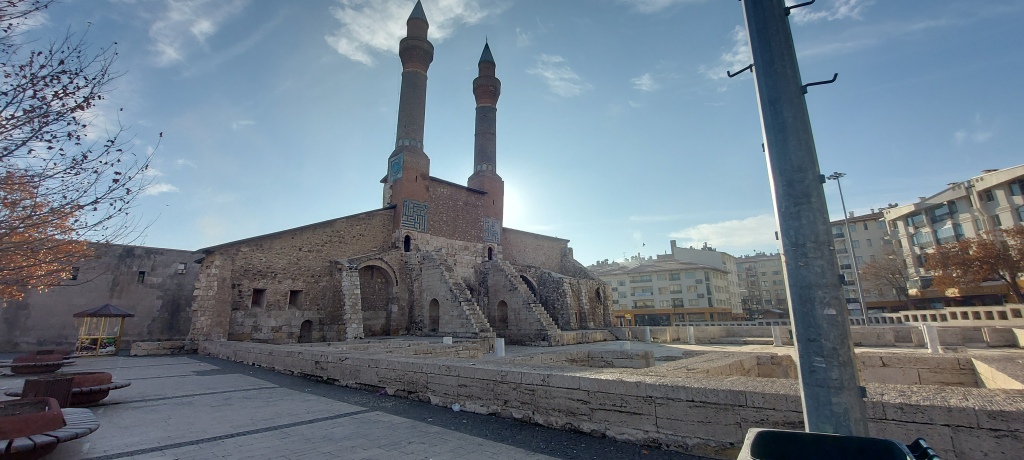
If you’re coming from the east side of the city, you will be able to immediately see the twin minarets of the Çifte Minare Medresesi (twin minaret religious school) Although most of the building is in ruins, the front facade and the characteristic two minarets still stands today. Looking at it up close, despite its ruined state, is a marvel to see. It makes you wonder how, several hundred years ago, our ancestors can do such complicated art. The arabesques, the muqarnas, the kufic calligraphy and the geometric design are all carved masterfully onto the walls of the madrasa. Imagine to study in these kind of schools where you are always surrounded with these amazing art!
Just across the Çifte Minareli Medrese, is another madrasa called Şifaiye Medresesi where it was once both a hospital (Darüşşifa) and a school for medical studies – hence the name . Now it is a bazaar where the local handicrafts for tourists are sold here as well as a cafe. It features a large courtyard with a fountain in the middle. The whole place was calm, and no one was pushing you to buy anything. If all, they were a bit surprised to see a foreigner in their city. On one side of the Medrese there was a beautifully decorated facade. This is the burial place of the Rum Seljuk Sultan Izeddin Keykavus I. The facade is a beautiful example of Seljuk art and architecture, and although you cannot enter the chamber itself, you can peer inside, revealing a dark room with a beautifully carved mihrab. Soft light shines from the four windows on two sides of the room, falling on the tiled cenotaphs that lies within.
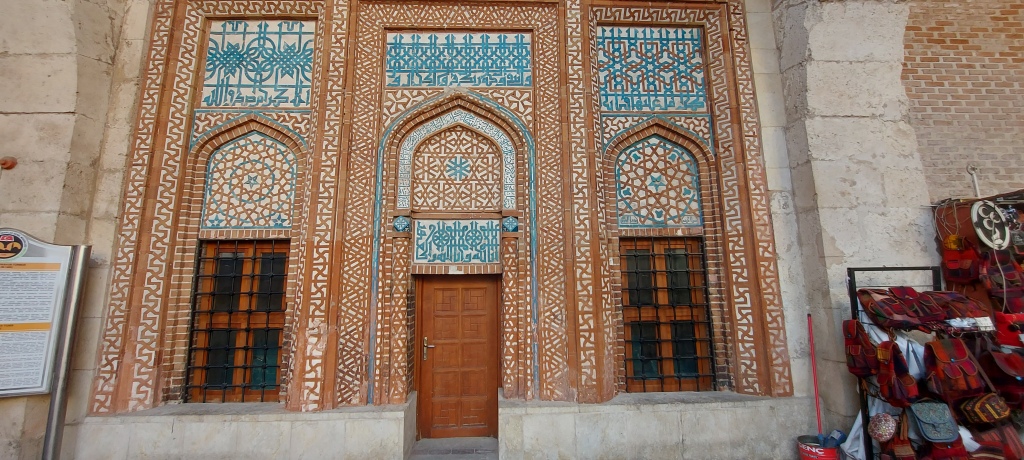
A very short walk away is the Kale Mosque, an Ottoman Era mosque build by Sultan Murad III’s governor to Sivas Ali Beyoğlu Mahmud Paşa in 1580 thus the alternative name Mahmud Paşa mosque. It bears all the characteristics of the Ottoman mosque. The building is essentially a square mosque, topped with an elegant low dome. Inside the mosque is simple but beautifully decorated with tiles and painted ornaments. The Mihrab and Mimbar are minimally decorated but made from luxurious marble. A singular minaret stands west of the mosque. In the outside there was a curious stone called the Sadaka taşi where alms were given and taken in anonymity in the old days. nearby was a hammam which is a part of the mosque complex although unfortunately was left in ruins.

As I noted before, when I embarked on this journey I had a terrible pain in my legs that I could not walk a lot even in short distances. So when I finished touring the city centre and doing a little bit of shopping for the cold weather, I took a taxi and went straight back to the hotel to rest for the next day’s adventure.
Happy New Year 2024
Assalamualaikum and greeting to al my readers,
First of all, I would like to wish everyone a very happy new year, I pray for us all to be in good health and fortune for the rest of the year in the grace of Allah.
You might be wondering about the inactivity of the blog for the last few months of 2023. As everyone must know right now, there is a horrible genocide unfolding in Palestine perpetrated by Israel at the moment. Seeing these event on a daily basis while the world ignores the oppressed while the oppressors are being championed and the international community turns a blind eye as war crimes being committed daily without any repercussions and condemnation whatsoever is taking a toll on my mental health and subsequently my actual physical health.
I find myself to lack sleep everyday now, just to wake up in a sense of describable dread and the want to just keep sleeping as if it will make for a temporary solution and refuge against the depression.
Every time I ask in front of the computer and opening the website to post an article, my mind goes blank and i feel tired. I cannot articulate anything let alone type a readable post for the blog. Today I am pushing myself to write the first post for the year, and I hope I can actually make anything for the rest of year really.
And even reading through this article back I feel my mind still wandering to the issues we are facing today, my thoughts entangled in a horrible mess.
Anyways, please do whatever we can to help those who are in need, especially in Palestine. The world is hurling down into a dystopia and each and every one of us alive now are witnessing this happening.
Again I wish you a happy new year, and I hope we will enter the new year with a brighter future. Articles will come soon insya Allah, especially posts from my visit to Turkey last year.
war crime in gaza, palestine
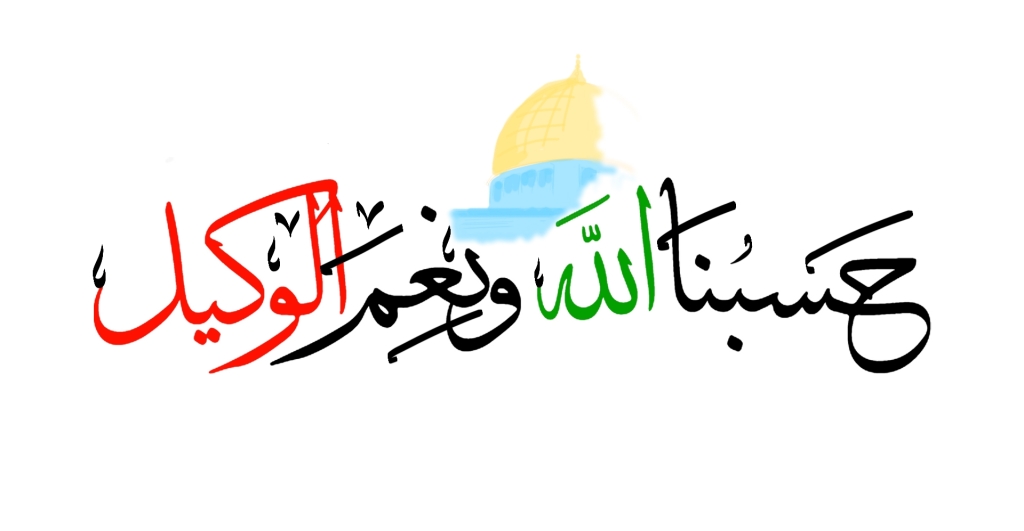
Nothing has been in my mind except for Gaza and Palestine since the war began earlier this month, and I don’t know how the world is still blind despite the clear intention and carrying out of war crimes and genocide by the occupying settlers.
I couldn’t elaborate my words as much and write articles about Islamic art and architecture when the third holiest site in Islam and the land of the prophets are being terrorized.
And as everyday we get harrowing news of the people in Gaza being bombed indiscriminately, they still are steadfast in defending their rightful homeland and wonder why were they so patient even as these horrors fall upon their heads.
And I keep hearing the same word over and over again, from the tongues of mourning mothers and fathers, weeping brothers and sisters and crying girls and boys –
,حسبنا الله ونعم ٱلوكيل ,حسبنا الله ونعم ٱلوكيل ,حسبنا الله ونعم ٱلوكيل
Sufficient for us is Allah, and [He is] the best Disposer of affairs
Please pray for our brothers and sisters and our fathers and mothers in Gaza, may they have all the patience in the World, and may they be victorious over those who wronged and transgressed.
In the meanwhile, please help and do whatever we can to spread awareness on this ongoing genocide which is being perpetrated right before our very eyes. If you are on Tiktok, Instagram and other social media, keep sharing the real news about the atrocities that are being committed. Keep boycotting the companies that are complicit in this madness. The world is very slowly but surely opening its eyes, and people from allover the world are finally realizing the mistake that is being done and the number of the supporters for the cause of the Palestinians are coming out in an unprecedented number now.
نَصْرٌ مِّن اللَّهِ وَفَتْحٌ قَرِيبٌ
(Surely) Help is from Allah, and victory is near.
Study – Turkish Mihrabs
I am still going through the pics and videos I had taken while I was studying Tezhip in Turkiye, but in the meantime let’s continue with the Mihrab series.
For this article, we will be looking in the Mihrabs in the Turkish mosques across all of the mosque architectural styles of the country. There are only a little differences with other Mihrabs from all around the world, however, there are a few points that I would like to discuss that makes Turkish mosques’ Mihrabs different. We shall be looking into the mihrab of mosques throughout the times, from the beginning of the establishment of Islam in Turkey up to the modern times.
History :
The history of mosques in Turkey is rich and diverse, reflecting the country’s deep Islamic heritage. The establishment of mosques in Turkey can be traced back to the 7th and 8th centuries when Arab armies conquered the region and introduced Islam. The rapid spread of Islam led to the construction of numerous mosques throughout the country.
One significant mosque in Turkey is the Hagia Sophia Mosque in Istanbul. Originally built as a church by the Eastern Roman Empire, it was later converted into a mosque during the Ottoman period. The Hagia Sophia Mosque, with its magnificent dome and intricate architectural design, stands as a testament to the blending of Byzantine and Ottoman architectural styles.
Another prominent mosque in Turkey is the Blue Mosque, officially known as the Sultan Ahmet Mosque. Constructed in the early 17th century, it is famous for its striking blue tilework and six minarets. The Blue Mosque is an embodiment of Istanbul’s grandeur and spirituality, attracting locals and tourists alike
Throughout Turkey, there are numerous mosques of historical and architectural significance. From the Çamlıca Mosque in Istanbul, one of the largest mosques in the city, to the Selimiye Mosque in Edirne, recognized as a UNESCO World Heritage site, each mosque has its own unique history and architectural style.
Influences :
The architectural influences on Turkish mosques are diverse and encompass a range of historical and cultural factors. Ottoman architecture, in particular, has significantly influenced the design and construction of Turkish mosques. During the Ottoman Empire, which lasted from the 14th to the early 20th century, mosques were built with a distinctive style that combined elements from various architectural traditions.
One notable influence on Turkish mosque architecture is Byzantine architecture. The incorporation of Byzantine architectural features can be seen in the use of large domes, elaborate interiors, and the incorporation of decorative elements such as mosaics and frescoes. The Hagia Sophia Mosque, formerly a Byzantine church, is a prime example of this architectural influence, with its impressive dome and Byzantine-style decorations.
Islamic architecture from other regions also played a role in shaping the design of Turkish mosques. Persian and Arab architectural styles, such as the use of minarets, courtyard layouts, and geometric geometricornamentation, have influenced Turkish mosque architecture. The Great Mosque of Damascus and the Dome of the Rock in Jerusalem are early Islamic architectural examples that influenced subsequent mosque designs.
Additionally, the Seljuks, a Turkic dynasty that ruled parts of Anatolia during the 11th to 13th centuries, contributed to the architectural influences on Turkish mosques. Seljuk architecture featured ornate stone carvings, intricate tilework, and the extensive use of arches and vaults. These elements can be observed in mosques built during the Seljuk era, such as the Alaeddin Mosque in Konya.
It is also worth mentioning that architectural styles have evolved over time, and modern designs have incorporated a variety of influences, emphasizing creativity and innovation while still maintaining a connection to traditional Turkish mosque architecture5.
Overall, Turkish mosque architecture is a fusion of various influences, including Byzantine, Persian, Arab, and Seljuk traditions. This combination of styles has resulted in the unique and diverse architectural heritage seen in Turkish mosques today.
Shape and Form :
During the Ottoman Empire, which lasted from the 14th to the early 20th century, mosques were built with a distinctive style that combined elements from various architectural traditions.
One notable influence on Turkish mosque architecture is Byzantine architecture. The incorporation of Byzantine architectural features can be seen in the use of large domes, elaborate interiors, and the incorporation of decorative elements such as mosaics and frescoes1. The Hagia Sophia Mosque, formerly a Byzantine church, is a prime example of this architectural influence, with its impressive dome and Byzantine-style decorations.
Islamic architecture from other regions also played a role in shaping the design of Turkish mosques. Persian and Arab architectural styles, such as the use of minarets, courtyard layouts, and geometric geometric ornamentation, have influenced Turkish mosque architecture. The Great Mosque of Damascus and the Dome of the Rock in Jerusalem are early Islamic architectural examples that influenced subsequent mosque designs.
Additionally, the Seljuks, a Turkic dynasty that ruled parts of Anatolia during the 11th to 13th centuries, contributed to the architectural influences on Turkish mosques. Seljuk architecture featured ornate stone carvings, intricate tilework, and the extensive use of arches and vaults4. These elements can be observed in mosques built during the Seljuk era, such as the Alaeddin Mosque in Konya.
It is also worth mentioning that architectural styles have evolved over time, and modern designs have incorporated a variety of influences, emphasizing creativity and innovation while still maintaining a connection to traditional Turkish mosque architecture.
Examples :






Internet Finds : AramcoWorld’s Art of Islamic Patterns videos
I have been a subscriber to AramcoWorld magazines for quite some time now, to the point that my one part of my bookcase is filled with the magazines I received all these years. However, since the pandemic happened in 2020 I have only received the hard copies periodically even though I am still a subscriber. I am not sure what happened there, but since then I have moved on the digital version of the magazine. At fist I only thought that the digital version is that – the digitized hard copy of the magazine. But it offered so much more, especially in the form of interactive contents.
Just recently I have realized that they have a collection of multimedia offerings including audio articles (which are essentially audiobooks), photo archives, recipes for traditional food and videos. And in their video collection I found articles that would be very helpful for us who are interested in Islamic art.
Among the collection of documentary and music videos you can also find tutorial videos, which covered geometric motifs and designs specific to certain region in the Islamic world – South East Asian vegetal motifs or Andalucian geometric patterns, for example. Along with these professionally made videos they are accompanied with corresponding articles where you can learn even more about the subject matter.
This video is an introduction to the Islamic patterns but you can find more videos on making the pattern themselves on the website.
If you are interested, you can go to the videos of AramcoWorld here
Study – Minarets Pt.7 : Indian
After a long hiatus, I am back with my writing finally! I am still sorting through all the photos that I took during my study trip to Turkiye a few months ago, and maybe I will edit a few and post videos showcasing the different mosques and places of interest, so don’t forget to watch them when its up and running!
In the meanwhile, for this part of the Minaret study series, we are looking into the minarets of the Indian subcontinent. The minarets from this subcontinent is quite interesting as it showcases an amalgamation of different artistic heritages, and a mix of the old, ancient preexisting culture and the newly introduced culture.
History :
Islam has a rich history in the Indian Subcontinent. In India, Islam is the country’s second-largest religion. The presence of Islam in India dates back to the 7th century when Arab traders established contacts with the Indian subcontinent. Over the centuries, Muslim empires, such as the Delhi Sultanate and the Mughal Empire, played a significant role in shaping the region’s culture, art, and architecture.
Influences :
Islamic architecture in the Indian subcontinent is a testament to the rich cultural heritage of the region. Influenced by various dynasties and empires, such as the Bengal Sultanate, Delhi Sultanate, Mughals, and Deccan Sultanates, Islamic architecture in India showcases a unique blend of Persian, Central Asian, and local ancient indigenous styles. The most iconic examples include the magnificent Mughal structures like the Taj Mahal, Humayun’s Tomb, and Jama Masjid in Delhi. These architectural marvels feature intricate geometric patterns, calligraphy, domes, minarets, and ornate entrances, reflecting the grandeur and elegance of Islamic aesthetics. Islamic architecture in the Indian subcontinent serves as a reminder of the historical and cultural significance of Islam in the region.
Until the 12th century, it remained a marginal phenomenon influenced by Middle Eastern Persian architecture. However, the Sultanate of Delhi in the 12th century marked the beginning of Islamic architecture in the region . Indo-Islamic architecture originated in the subcontinent and was influenced by both Persian and Indian styles. The main architectural styles in northern India are the Sultanate of Delhi and the Mughal Empire. The earliest surviving examples of Islamic architecture date from the late 12th century in Delhi, with notable structures like the Qūwat-ul-Islām mosque and the Quṭb Mīnār tower .
Shape and Form :
As the Indian Islamic architecture draws influences from Central Asia and Persia as well as the local ancient Hindu artistic heritage, we can see clearly the elements from each of these cultures and represented in the architecture of Islamic Indian Subcontinent.
Indian minarets are commonly slender with a number of balconies along the minaret itself, usually in threes. The general shape of the minaret follows closely Persian and Central Asian style. However, there are also elements from the ancient Hindu architecture ; Chattris (domed pavillions) usually top these minarets with notched corbel arches. The minarets are often fluted, giving an impression of the minarets is in the shape of a lotus stalk with the Chattris as the bloom of the flower. The lotus is an important motif in Hinduism and Buddhism, as such it influences the art and architecture in India.
Examples :




Eid Al Adha MUBARAK

Assalamualaikum and hello everyone,
I would like to take this chance to say Eid Al Adha Mubarak to you all my readers. May the celebrations bring you and your family endless happiness and joy and may all our good deeds on these joyous celebrations be accepted by Allah, amin.
A little update ; I am still currently recovering and I could not do much work but Insya Allah I will continue the blog once I feel good enough. By this time I couldn’t even think of typing an articles a few lines long!
Once again I hope you all have a joyous Eid Al Adha.


